TIM ROBINSON FRAeS previews the upcoming RAF Global Air and Space Chiefs Conference (GASCC), set to take place in London on the 13-14 July at the IET in London.
Taking place in London on 13-14 July, the Royal Air Force’s Chief of the Air Staff’s Global Air and Space Chiefs' Conference (formerly known as the RAF Air Power Conference) returns in force after two years of the Covid pandemic prevented high-level aerospace professionals from around the world from meeting in person.
It also returns in a world where old assumptions have been shattered and thrown out of the window, and where a state-on-state war in Eastern Europe in redefining air power and has brought NATO closer together than at the start of the Cold War. Indeed, Moscow’s aggression has also upended decades of geopolitical security – bringing into the Alliance two new countries in the form of Finland and Sweden. It will thus be a key forum for air and space chiefs to demonstrate their resolve in the face of this crisis – with an overall theme of ‘Maintaining Our Leading Edge’. It is also worth remembering, that only 12 months ago, that the US and NATO exited Afghanistan in a withdrawal that led some to believe that the West was a spent force, US power diminished and that NATO irrelevant. One year later and the opposite has taken place.
Organised by the UK’s Air and Space Power Association, this year GASCC brings together over 50 air and space force chiefs as part of almost 450 military professionals, defence industry executives, academics and media in a two-day conference ahead of the Royal International Air Tattoo on Friday and Farnborough Air Show the following week – making it a must-attend event for discussion, debate and networking.
Confirmed speakers include the UK Defence Secretary Rt Hon Ben Wallace MP, Chief of the Air Staff, ACM Sir Mike Wigston, Chief of the US Air Force, Gen Charles Q Brown, and General 'Jay' Raymond, Chief of Space Operations, US Space Force. As well as the military top brass, GASCC is set to host some of the world's most innovative defence thinkers such as former USAF acquisition chief Dr Will Roper, Dr Keith Dear and Professor Adam Beaumont in a session entitled ‘from hybrid-war to hyper war’. Meanwhile another session, entitled ‘Terra-Tech-Tonics’ will see speakers from Leonardo, BAE Systems, Lockheed Martin Skunk Works, Airbus and Northrop Grumman discuss AI and machine learning, and emerging technologies in the five domains (land, air, sea, space and cyber) and four dimensions (including time). As well as operational integration, data/digital and space the conference will also include sessions on ethics and morals along with sustainability and skills. In particular, while much (well-deserved criticism) has been levelled at US and coalition forces for drone warfare in Iraq and Afghanistan over the past two decades, the ruthless indiscriminate bombing of clearly civilian targets in Ukraine by Russia has been a reminder of the death and destruction that can be unleashed when an air force does not care about collateral damage.
Elsewhere, climate change concerns have accelerated the pursuit of NetZero, and the decarbonisation agenda is now closely linked with energy security and weaning the West off Russian oil and gas. Indeed the second day promises a key step in global air and space chiefs coming together to tackle this with a Air Chiefs’ Declaration of Intention on Climate Change, a visible sign of how the RAF is still the leading the way in this new challenge.
Let’s take a look at some of the potential key themes and topics.
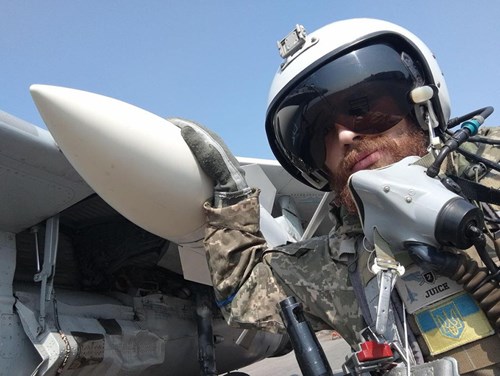
What can 'Juice' and his fellow pilots teach the world's air forces? (Ukrainian Air Force)
Undoubtedly a major talking point at GASCC this year will be the Ukraine war and its lessons for air, space and multidomain professionals. The war has overturned many analysts’ expectations – and it incredible to think that some four months on, the Ukrainian Air Force still remains in the fight against a far larger opponent. Key questions then will be does Kyiv’s use of armed consumer drones, distributed anti-tank teams, Turkish TB2s and commercial Starlink broadband communications represent a glimpse of a new type of warfare, where smaller countries can resist larger opponents, by clever use of multidomain operations? Or is this a historical one-off, against an opponent with a large, but hollowed-out military that is fighting a 1970s-style war and an air force unable to mount complex operations? Are the iconic Turkish TB2 drones that wreaked havoc on advancing Russian forces a future vision of low-cost SEAD/DEAD, or a one-off gimmick that merely exploited poor readiness and tactics of Russian SAM operators in the early stages of the campaign?
Furthermore, now that the West and NATO are effectively in a proxy war with Moscow – how far will this support and assistance go? Is there, in fact any difference between NATO nations supplying heavy artillery and advanced long-range rocket systems, and say F-16s, F-18s or surplus Eurofighters? And finally, are the West’s stockpiles of precision munitions and missiles enough for a full-scale peer-on-peer conflict – or, like the Russian AF, would NATO air forces have to revert to dumb bombs in a protracted conflict? Though the war in Ukraine is not yet over, it is likely that air and space professionals will be studying this for decades.
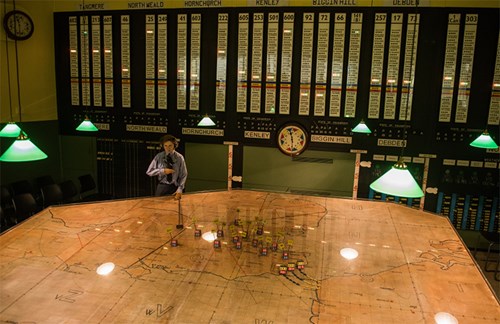
Was RAF Fighter Command's command and control system the first use of a 'network-centric' system in air warfare? (Battle of Britain Bunker)
Are we on the cusp of new era in air warfare? Certainly, this question has been asked before, in previous decades with the advent of drone operations, network centric warfare and the revolution in military affairs (RMA). Today the current geopolitical situation has often been compared the interwar years – with the West now racing to rearm.
However, it is instructive in considering a previous revolution that resulted in the RAF’s integrated defence system of 1940 that won the Battle of Britain. While now it is obvious, in the 1920/30s the separate parts may have just seemed evolutions of previous technology – faster, better armed fighters and a way of putting them in the same part of sky that was one step beyond ground observers.
For example, eight-gun monoplane fighters needed radar to intercept bombers, radios to communicate with pilots, IFF and the filter control centres of RAF Fighter Command – otherwise these Spitfire and Hurricanes would have been useless. Conversely biplane fighters, directed to enemy air raids by radar, would have either been massacred or left behind by the new generation of faster bombers. Even Britain’s production system, pilot training and maintenance and repair might be considered as part of this wider ‘system’ that ensured victory in 1940, against an opponent that had steamrolled through Europe.
On their own, each of these advances may have seemed an evolution but, put together they arguably created a revolution in air warfare – and one that with Quick Reaction Alerts, jet fighters and radar-controlled intercepts, still prevails today.
Fast forward to 2022, and there are also a number of technology trends and advances that are also coming together – such as hypersonics, fifth-generation stealth, cognitive EW, space ISR, cyber, AI, swarming drones, 3D printing of spare parts, ‘loyal wingman’ and advanced human-machine interfaces that merged may constitute a whole new phase of warfare.
One of the key topics then will be to encourage thinking among air power practitioners of fused multidomain operations – a step further than being merely ‘joint’. While air and space domains are natural bedfellows, cyber still sits a little apart, yet all will be needed to be fused deeply if this new era of multidomain warfare will really be more than the sum of its parts.
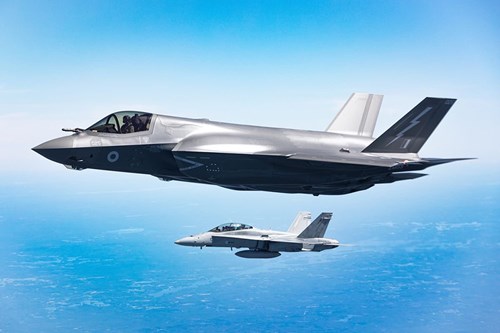
NATO standard datalinks, secure radios, precision weapons are the minimum buy-in for coalition partners wanting to fight along side the US. But what will these be in the future? (NATO Air Command)
Indeed, while some nations are racing ahead in developing this new form of multidomain warfare, another key topic from this conference, which as in its title Global Air & Space Chiefs suggests, is how to carry other allied and coalition partners along so they can contribute to the fight. Long memories of previous US-led campaigns where some air forces lacked secure radios, IFF, NVGs or the latest weapons have meant that since the early 1990s exercises such as Red Flag have provided the baseline US standard of international cooperation for global air forces to aim for.
However, with the goalposts moving so swiftly now, and technology accelerating ever faster – how do these second and third tier air arms integrate with the might of the US military – if joining an alliance or a coalition? Will air arms without hypersonics, satellite ISR, or swarming drones be the equivalent of a 1930s air force with two-gun, radio-less biplane fighters attempting to integrate with a 1944 air defence system, with radar and electronic warfare?
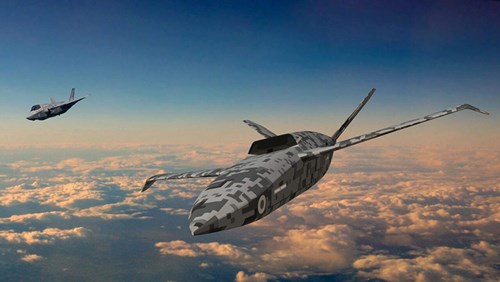
The UK has cancelled the Mosquito 'Loyal Wingman' first launched at LANCA in 2015. Can cheaper, smaller drones do a similar job? (UK MoD)
Meanwhile, this acceleration to 'hyper war’ may in fact, help explain the thinking behind the recent surprise cancellation of the RAF’s Mosquito ‘Loyal Wingman’ programme – and its reorientation into smaller, faster and cheaper ‘adjuncts’ that can be fielded in the near-term. Experience from Ukraine has shown the growing power of the ‘air littoral’ where consumer drones can hunt down tanks at night, with grenades and 3D printed fins - or where HD cameras can provide shot correction for artillery – seemingly without much interference. While drones are being shot down and lost, the sheer number of these cheap UAVs means that for both ground and air forces, dominating this low-level environment will now be a key challenge. Expect searching questions on the rationale for the cancellation of this ‘loyal wingman’ project from the floor.
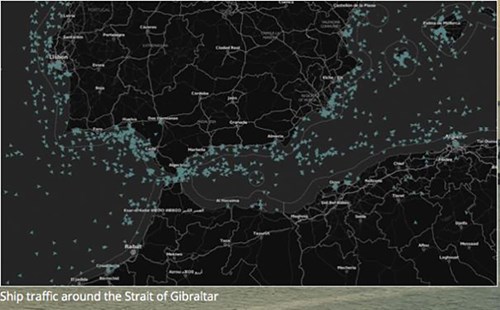
Ship tracking via SPIRE satellites. Given the slow speed of ships, do these need updating every second, minute or hour? (SPIRE)
One of the current buzz-phrases one will be liable to hear at the conference is ‘the speed of relevance’. This is distinct from previous phrases about ‘shortening the kill chain’ as it incorporates more nuance and the aim is not just faster kinetic strikes, but supplying intelligence precisely where and when it is needed. It may be that commanders need a port checked for enemy shipping every day, or a high-value target on the ground tracked minute-by-minute. Or it may be a more open-ended timeline to discover and report on an enemy capability when it first appears in a theatre of operations. Each of these thus has its own unique priority and the phrase ‘decision-making at the speed of relevance’ thus underscores the need to timely and accurate intelligence to be provided when it is really needed – rather than overwhelming commanders with a firehose of data that today’s sensors and systems can provide. ‘Hyper-war’ then, may not just be about pure speed (in hypersonics or advanced AI) but in providing actionable intelligence just when it is needed, and not before or after.

Stay of execution? Could the RAF's hard-working Hercules fleet be kept on? (RAF)
Meanwhile, the conference will be extremely timely in helping to digest the implications of increased defence spending for both the UK and its partners. Only last week, at the NATO summit, UK Prime Minister Boris Johnson promised that defence spending as a proportion of GDP would rise to 2.5% by the end of the decade – with some sources saying that this will exclude money earmarked for Ukraine, resulting in a 2030 budget of £74.5bn. This will help meet not only the severe economic inflationary pressures that were already outstripping defence inflation, but also near term and longer-term equipment priorities – such as FCAS and Tempest. There are already reports then that the UK’s decision to retire the C-130J airlift fleet may be now on hold. With this promised UK defence funding boost, there could be therefore be key hints of revised and updated procurement requirements.
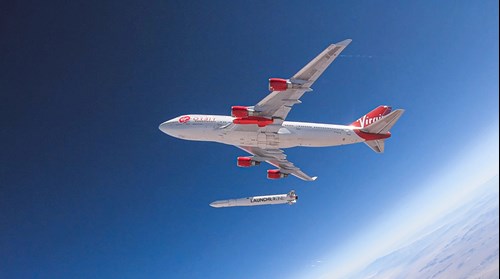
We are now moving to an era of merged air/space forces. (Virgin Orbit)
In short, while previous RAF air power conferences have undoubtedly been provided much food for thought for the global air and space power community, the stark reality of the Ukraine conflict and its spiralling, multifaceted implications means that the 2022 GASCC will, this year, be an event that is set to gain interest from a far wider audience than ever before.
With over 50 of the world's air and space chiefs set to attend, the lessons learned and thought leadership from the RAF and CAS facilitated by this high-level forum for debate and discussion are thus likely to accelerate capability sharing and integration for this new era of multidomain 'hyperwar'.
Tim Robinson
5 July 2022

 www.aerosociety.com
www.aerosociety.com
Taking place in London on 13-14 July, the Royal Air Force’s Chief of the Air Staff’s Global Air and Space Chiefs' Conference (formerly known as the RAF Air Power Conference) returns in force after two years of the Covid pandemic prevented high-level aerospace professionals from around the world from meeting in person.
It also returns in a world where old assumptions have been shattered and thrown out of the window, and where a state-on-state war in Eastern Europe in redefining air power and has brought NATO closer together than at the start of the Cold War. Indeed, Moscow’s aggression has also upended decades of geopolitical security – bringing into the Alliance two new countries in the form of Finland and Sweden. It will thus be a key forum for air and space chiefs to demonstrate their resolve in the face of this crisis – with an overall theme of ‘Maintaining Our Leading Edge’. It is also worth remembering, that only 12 months ago, that the US and NATO exited Afghanistan in a withdrawal that led some to believe that the West was a spent force, US power diminished and that NATO irrelevant. One year later and the opposite has taken place.
Organised by the UK’s Air and Space Power Association, this year GASCC brings together over 50 air and space force chiefs as part of almost 450 military professionals, defence industry executives, academics and media in a two-day conference ahead of the Royal International Air Tattoo on Friday and Farnborough Air Show the following week – making it a must-attend event for discussion, debate and networking.
Confirmed speakers include the UK Defence Secretary Rt Hon Ben Wallace MP, Chief of the Air Staff, ACM Sir Mike Wigston, Chief of the US Air Force, Gen Charles Q Brown, and General 'Jay' Raymond, Chief of Space Operations, US Space Force. As well as the military top brass, GASCC is set to host some of the world's most innovative defence thinkers such as former USAF acquisition chief Dr Will Roper, Dr Keith Dear and Professor Adam Beaumont in a session entitled ‘from hybrid-war to hyper war’. Meanwhile another session, entitled ‘Terra-Tech-Tonics’ will see speakers from Leonardo, BAE Systems, Lockheed Martin Skunk Works, Airbus and Northrop Grumman discuss AI and machine learning, and emerging technologies in the five domains (land, air, sea, space and cyber) and four dimensions (including time). As well as operational integration, data/digital and space the conference will also include sessions on ethics and morals along with sustainability and skills. In particular, while much (well-deserved criticism) has been levelled at US and coalition forces for drone warfare in Iraq and Afghanistan over the past two decades, the ruthless indiscriminate bombing of clearly civilian targets in Ukraine by Russia has been a reminder of the death and destruction that can be unleashed when an air force does not care about collateral damage.
Elsewhere, climate change concerns have accelerated the pursuit of NetZero, and the decarbonisation agenda is now closely linked with energy security and weaning the West off Russian oil and gas. Indeed the second day promises a key step in global air and space chiefs coming together to tackle this with a Air Chiefs’ Declaration of Intention on Climate Change, a visible sign of how the RAF is still the leading the way in this new challenge.
Let’s take a look at some of the potential key themes and topics.
Lessons from Ukraine

What can 'Juice' and his fellow pilots teach the world's air forces? (Ukrainian Air Force)
Undoubtedly a major talking point at GASCC this year will be the Ukraine war and its lessons for air, space and multidomain professionals. The war has overturned many analysts’ expectations – and it incredible to think that some four months on, the Ukrainian Air Force still remains in the fight against a far larger opponent. Key questions then will be does Kyiv’s use of armed consumer drones, distributed anti-tank teams, Turkish TB2s and commercial Starlink broadband communications represent a glimpse of a new type of warfare, where smaller countries can resist larger opponents, by clever use of multidomain operations? Or is this a historical one-off, against an opponent with a large, but hollowed-out military that is fighting a 1970s-style war and an air force unable to mount complex operations? Are the iconic Turkish TB2 drones that wreaked havoc on advancing Russian forces a future vision of low-cost SEAD/DEAD, or a one-off gimmick that merely exploited poor readiness and tactics of Russian SAM operators in the early stages of the campaign?
Furthermore, now that the West and NATO are effectively in a proxy war with Moscow – how far will this support and assistance go? Is there, in fact any difference between NATO nations supplying heavy artillery and advanced long-range rocket systems, and say F-16s, F-18s or surplus Eurofighters? And finally, are the West’s stockpiles of precision munitions and missiles enough for a full-scale peer-on-peer conflict – or, like the Russian AF, would NATO air forces have to revert to dumb bombs in a protracted conflict? Though the war in Ukraine is not yet over, it is likely that air and space professionals will be studying this for decades.
On the threshold of a new era in warfare?

Was RAF Fighter Command's command and control system the first use of a 'network-centric' system in air warfare? (Battle of Britain Bunker)
Are we on the cusp of new era in air warfare? Certainly, this question has been asked before, in previous decades with the advent of drone operations, network centric warfare and the revolution in military affairs (RMA). Today the current geopolitical situation has often been compared the interwar years – with the West now racing to rearm.
However, it is instructive in considering a previous revolution that resulted in the RAF’s integrated defence system of 1940 that won the Battle of Britain. While now it is obvious, in the 1920/30s the separate parts may have just seemed evolutions of previous technology – faster, better armed fighters and a way of putting them in the same part of sky that was one step beyond ground observers.
For example, eight-gun monoplane fighters needed radar to intercept bombers, radios to communicate with pilots, IFF and the filter control centres of RAF Fighter Command – otherwise these Spitfire and Hurricanes would have been useless. Conversely biplane fighters, directed to enemy air raids by radar, would have either been massacred or left behind by the new generation of faster bombers. Even Britain’s production system, pilot training and maintenance and repair might be considered as part of this wider ‘system’ that ensured victory in 1940, against an opponent that had steamrolled through Europe.
On their own, each of these advances may have seemed an evolution but, put together they arguably created a revolution in air warfare – and one that with Quick Reaction Alerts, jet fighters and radar-controlled intercepts, still prevails today.
Fast forward to 2022, and there are also a number of technology trends and advances that are also coming together – such as hypersonics, fifth-generation stealth, cognitive EW, space ISR, cyber, AI, swarming drones, 3D printing of spare parts, ‘loyal wingman’ and advanced human-machine interfaces that merged may constitute a whole new phase of warfare.
One of the key topics then will be to encourage thinking among air power practitioners of fused multidomain operations – a step further than being merely ‘joint’. While air and space domains are natural bedfellows, cyber still sits a little apart, yet all will be needed to be fused deeply if this new era of multidomain warfare will really be more than the sum of its parts.
Keeping partners connected

NATO standard datalinks, secure radios, precision weapons are the minimum buy-in for coalition partners wanting to fight along side the US. But what will these be in the future? (NATO Air Command)
Indeed, while some nations are racing ahead in developing this new form of multidomain warfare, another key topic from this conference, which as in its title Global Air & Space Chiefs suggests, is how to carry other allied and coalition partners along so they can contribute to the fight. Long memories of previous US-led campaigns where some air forces lacked secure radios, IFF, NVGs or the latest weapons have meant that since the early 1990s exercises such as Red Flag have provided the baseline US standard of international cooperation for global air forces to aim for.
However, with the goalposts moving so swiftly now, and technology accelerating ever faster – how do these second and third tier air arms integrate with the might of the US military – if joining an alliance or a coalition? Will air arms without hypersonics, satellite ISR, or swarming drones be the equivalent of a 1930s air force with two-gun, radio-less biplane fighters attempting to integrate with a 1944 air defence system, with radar and electronic warfare?
Mosquito swatted

The UK has cancelled the Mosquito 'Loyal Wingman' first launched at LANCA in 2015. Can cheaper, smaller drones do a similar job? (UK MoD)
Meanwhile, this acceleration to 'hyper war’ may in fact, help explain the thinking behind the recent surprise cancellation of the RAF’s Mosquito ‘Loyal Wingman’ programme – and its reorientation into smaller, faster and cheaper ‘adjuncts’ that can be fielded in the near-term. Experience from Ukraine has shown the growing power of the ‘air littoral’ where consumer drones can hunt down tanks at night, with grenades and 3D printed fins - or where HD cameras can provide shot correction for artillery – seemingly without much interference. While drones are being shot down and lost, the sheer number of these cheap UAVs means that for both ground and air forces, dominating this low-level environment will now be a key challenge. Expect searching questions on the rationale for the cancellation of this ‘loyal wingman’ project from the floor.
The speed of relevance
Ship tracking via SPIRE satellites. Given the slow speed of ships, do these need updating every second, minute or hour? (SPIRE)
One of the current buzz-phrases one will be liable to hear at the conference is ‘the speed of relevance’. This is distinct from previous phrases about ‘shortening the kill chain’ as it incorporates more nuance and the aim is not just faster kinetic strikes, but supplying intelligence precisely where and when it is needed. It may be that commanders need a port checked for enemy shipping every day, or a high-value target on the ground tracked minute-by-minute. Or it may be a more open-ended timeline to discover and report on an enemy capability when it first appears in a theatre of operations. Each of these thus has its own unique priority and the phrase ‘decision-making at the speed of relevance’ thus underscores the need to timely and accurate intelligence to be provided when it is really needed – rather than overwhelming commanders with a firehose of data that today’s sensors and systems can provide. ‘Hyper-war’ then, may not just be about pure speed (in hypersonics or advanced AI) but in providing actionable intelligence just when it is needed, and not before or after.
Defence budget boost?

Stay of execution? Could the RAF's hard-working Hercules fleet be kept on? (RAF)
Meanwhile, the conference will be extremely timely in helping to digest the implications of increased defence spending for both the UK and its partners. Only last week, at the NATO summit, UK Prime Minister Boris Johnson promised that defence spending as a proportion of GDP would rise to 2.5% by the end of the decade – with some sources saying that this will exclude money earmarked for Ukraine, resulting in a 2030 budget of £74.5bn. This will help meet not only the severe economic inflationary pressures that were already outstripping defence inflation, but also near term and longer-term equipment priorities – such as FCAS and Tempest. There are already reports then that the UK’s decision to retire the C-130J airlift fleet may be now on hold. With this promised UK defence funding boost, there could be therefore be key hints of revised and updated procurement requirements.
Summary

We are now moving to an era of merged air/space forces. (Virgin Orbit)
In short, while previous RAF air power conferences have undoubtedly been provided much food for thought for the global air and space power community, the stark reality of the Ukraine conflict and its spiralling, multifaceted implications means that the 2022 GASCC will, this year, be an event that is set to gain interest from a far wider audience than ever before.
With over 50 of the world's air and space chiefs set to attend, the lessons learned and thought leadership from the RAF and CAS facilitated by this high-level forum for debate and discussion are thus likely to accelerate capability sharing and integration for this new era of multidomain 'hyperwar'.
Tim Robinson
5 July 2022

A new era of hyper warfare? - Royal Aeronautical Society
TIM ROBINSON FRAeS previews the upcoming RAF Global Air and Space Chiefs Conference, set to take place in London on the 13-14 July at the IET in London.

